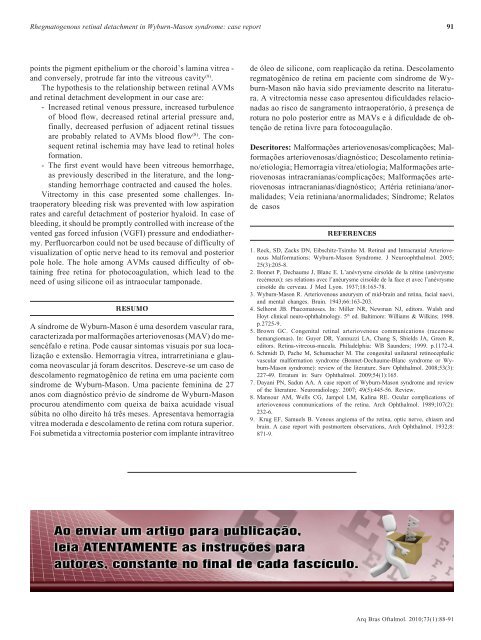Capa 2-ABO 73-01-Final.indd - Conselho Brasileiro de Oftalmologia
Capa 2-ABO 73-01-Final.indd - Conselho Brasileiro de Oftalmologia
Capa 2-ABO 73-01-Final.indd - Conselho Brasileiro de Oftalmologia
Create successful ePaper yourself
Turn your PDF publications into a flip-book with our unique Google optimized e-Paper software.
Rhegmatogenous retinal <strong>de</strong>tachment in Wyburn-Mason syndrome: case report<br />
91<br />
points the pigment epithelium or the choroid’s lamina vitrea -<br />
and conversely, protru<strong>de</strong> far into the vitreous cavity (9) .<br />
The hypothesis to the relationship between retinal AVMs<br />
and retinal <strong>de</strong>tachment <strong>de</strong>velopment in our case are:<br />
- Increased retinal venous pressure, increased turbulence<br />
of blood flow, <strong>de</strong>creased retinal arterial pressure and,<br />
finally, <strong>de</strong>creased perfusion of adjacent retinal tissues<br />
are probably related to AVMs blood flow (8) . The consequent<br />
retinal ischemia may have lead to retinal holes<br />
formation.<br />
- The first event would have been vitreous hemorrhage,<br />
as previously <strong>de</strong>scribed in the literature, and the longstanding<br />
hemorrhage contracted and caused the holes.<br />
Vitrectomy in this case presented some challenges. Intraoperatory<br />
bleeding risk was prevented with low aspiration<br />
rates and careful <strong>de</strong>tachment of posterior hyaloid. In case of<br />
bleeding, it should be promptly controlled with increase of the<br />
vented gas forced infusion (VGFI) pressure and endodiathermy.<br />
Perfluorcarbon could not be used because of difficulty of<br />
visualization of optic nerve head to its removal and posterior<br />
pole hole. The hole among AVMs caused difficulty of obtaining<br />
free retina for photocoagulation, which lead to the<br />
need of using silicone oil as intraocular tampona<strong>de</strong>.<br />
RESUMO<br />
A síndrome <strong>de</strong> Wyburn-Mason é uma <strong>de</strong>sor<strong>de</strong>m vascular rara,<br />
caracterizada por malformações arteriovenosas (MAV) do mesencéfalo<br />
e retina. Po<strong>de</strong> causar sintomas visuais por sua localização<br />
e extensão. Hemorragia vítrea, intrarretiniana e glaucoma<br />
neovascular já foram <strong>de</strong>scritos. Descreve-se um caso <strong>de</strong><br />
<strong>de</strong>scolamento regmatogênico <strong>de</strong> retina em uma paciente com<br />
síndrome <strong>de</strong> Wyburn-Mason. Uma paciente feminina <strong>de</strong> 27<br />
anos com diagnóstico prévio <strong>de</strong> síndrome <strong>de</strong> Wyburn-Mason<br />
procurou atendimento com queixa <strong>de</strong> baixa acuida<strong>de</strong> visual<br />
súbita no olho direito há três meses. Apresentava hemorragia<br />
vítrea mo<strong>de</strong>rada e <strong>de</strong>scolamento <strong>de</strong> retina com rotura superior.<br />
Foi submetida a vitrectomia posterior com implante intravítreo<br />
<strong>de</strong> óleo <strong>de</strong> silicone, com reaplicação da retina. Descolamento<br />
regmatogênico <strong>de</strong> retina em paciente com síndrome <strong>de</strong> Wyburn-Mason<br />
não havia sido previamente <strong>de</strong>scrito na literatura.<br />
A vitrectomia nesse caso apresentou dificulda<strong>de</strong>s relacionadas<br />
ao risco <strong>de</strong> sangramento intraoperatório, à presença <strong>de</strong><br />
rotura no polo posterior entre as MAVs e à dificulda<strong>de</strong> <strong>de</strong> obtenção<br />
<strong>de</strong> retina livre para fotocoagulação.<br />
Descritores: Malformações arteriovenosas/complicações; Malformações<br />
arteriovenosas/diagnóstico; Descolamento retiniano/etiologia;<br />
Hemorragia vítrea/etiologia; Malformações arteriovenosas<br />
intracranianas/complicações; Malformações arteriovenosas<br />
intracranianas/diagnóstico; Artéria retiniana/anormalida<strong>de</strong>s;<br />
Veia retiniana/anormalida<strong>de</strong>s; Síndrome; Relatos<br />
<strong>de</strong> casos<br />
REFERENCES<br />
1. Reck, SD, Zacks DN, Eibschitz-Tsimho M. Retinal and Intracranial Arteriovenous<br />
Malformations: Wyburn-Mason Syndrome. J Neuroophthalmol. 2005;<br />
25(3):205-8.<br />
2. Bonnet P, Dechaume J, Blanc E. L’anévrysme cirsoï<strong>de</strong> <strong>de</strong> la rétine (anévrysme<br />
recémeux): ses relations avec l’anéurysme cirsoï<strong>de</strong> <strong>de</strong> la face et avec l’anévrysme<br />
cirsoï<strong>de</strong> du cerveau. J Med Lyon. 1937;18:165-78.<br />
3. Wyburn-Mason R. Arteriovenous aneurysm of mid-brain and retina, facial naevi,<br />
and mental changes. Brain. 1943;66:163-203.<br />
4. Selhorst JB. Phacomatoses. In: Miller NR, Newman NJ, editors. Walsh and<br />
Hoyt clinical neuro-ophthalmology. 5 th ed. Baltimore: Williams & Wilkins; 1998.<br />
p.2725-9.<br />
5. Brown GC. Congenital retinal arteriovenous communications (racemose<br />
hemangiomas). In: Guyer DR, Yannuzzi LA, Chang S, Shields JA, Green R,<br />
editors. Retina-vitreous-macula. Phila<strong>de</strong>lphia: WB Saun<strong>de</strong>rs; 1999. p.1172-4.<br />
6. Schmidt D, Pache M, Schumacher M. The congenital unilateral retinocephalic<br />
vascular malformation syndrome (Bonnet-Dechaume-Blanc syndrome or Wyburn-Mason<br />
syndrome): review of the literature. Surv Ophthalmol. 2008;53(3):<br />
227-49. Erratum in: Surv Ophthalmol. 2009;54(1):165.<br />
7. Dayani PN, Sadun AA. A case report of Wyburn-Mason syndrome and review<br />
of the literature. Neuroradiology. 2007; 49(5):445-56. Review.<br />
8. Mansour AM, Wells CG, Jampol LM, Kalina RE. Ocular complications of<br />
arteriovenous communications of the retina. Arch Ophthalmol. 1989;107(2):<br />
232-6.<br />
9. Krug EF, Samuels B. Venous angioma of the retina, optic nerve, chiasm and<br />
brain. A case report with postmortem observations, Arch Ophthalmol. 1932;8:<br />
871-9.<br />
Arq Bras Oftalmol. 2<strong>01</strong>0;<strong>73</strong>(1):88-91
















